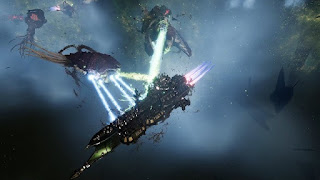In 11.024M42, the increasing threat of Hive Fleet Poseidon forced General Maximus, commander of the Imperial Crusade in the Rifts of Hecate, to confront the reality of the xenos menace. The Tyranid swarm had infiltrated and devastated several Imperial positions, and the Hive Fleet’s relentless advance threatened to render the entire region untenable.
Faced with the potential necessity of retreating to the Hecate Gap, Maximus grappled with the strategic and political ramifications of such a withdrawal. Already assigned to the Rifts after the controversial “retirement” of Sector Commander Titus Luthor—a move widely believed to have been orchestrated by the Inquisition—Maximus feared the loss of face this would entail. Determined to maintain his position, he leveraged his connections in the Imperial Navy to secure the support of Admiral Gorshkov, a commander of considerable skill and reputation.
Admiral Gorshkov’s Counterstrike
In late 11.024M42, Gorshkov’s fleet entered the embattled Helos Majoris system, where Tyranid bio-ships had established dominance over the Imperial base. Unlike previous encounters with Hive Fleet Poseidon, Gorshkov’s fleet was not caught off guard. Operating with precision and discipline, the Admiral directed his cruisers to methodically isolate and destroy individual bio-ships, avoiding the encircling tactics favored by the Tyranids.
The Imperial fleet’s nova cannons played a decisive role, delivering devastating salvos that obliterated the largest xenos bio-ships before they could respond. Smaller escort vessels, employing tight formations, screened the capital ships from Tyranid assault organisms, ensuring minimal losses. By the battle’s end, the remnants of the Tyranid swarm in the Helos Majoris system were annihilated, allowing the fleet to commence orbital bombardment of key Tyranid positions on Heloris Majoris.
A Temporary Victory
While the success of Gorshkov’s counterstrike bought the Imperium time, it was far from a decisive blow against Hive Fleet Poseidon. The Tyranids’ adaptability became immediately evident in the aftermath. Rather than continuing to challenge the Imperial Navy directly, the Hive Mind shifted its tactics, focusing on attrition and subterfuge. Swarms began targeting vulnerable supply lines, isolated bases, and undefended worlds, avoiding large-scale engagements where the Imperium’s firepower would dominate.
On Heloris Majoris, the planetary defenses were temporarily bolstered by the victory, but the planet remained scarred by Tyranid infiltration. Despite the orbital bombardments, the biosphere had been irrevocably altered, and Tyranid organisms continued to linger in the wilds, complicating the efforts of Imperial forces to reestablish full control.
Strategic Implications
The Battle of Helos Majoris highlighted both the strengths and weaknesses of the Imperium’s approach to combating Hive Fleet Poseidon. While the Imperial Navy demonstrated its ability to crush Tyranid bio-ships in direct engagements, the Hive Fleet had no intention of allowing such confrontations in the future.
For General Maximus, the victory delayed his feared retreat to the Hecate Gap and preserved his fragile position in the Crusade. However, his failure to anticipate the Hive Fleet’s adaptability left many Imperial commanders questioning his overall strategy. As 024M42 drew to a close, it was clear that the Imperium’s presence in the Rifts of Hecate remained precarious, with Hive Fleet Poseidon continuing to evolve and outmaneuver the Crusade forces.
The Rifts had become a battleground of attrition, and the battle for Helos Majoris was but one chapter in an ongoing war of survival against the xenos scourge.

No comments:
Post a Comment